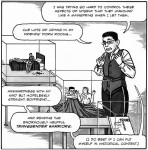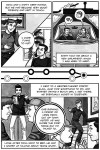In a recent review, I wrote about the rise of trans-themed comics, and its importance in the current queer comics landscape. I’m glad to say we’ve got another proof of that with Dylan Edwards’s Transposes1, a collection of biographical short stories presenting the life of 7 “queer-identified female-to-men transpeople”, in the words of the author.
In her introduction to the book, Alison Bechdel, who knows something about the use of words and images, makes a few good points about Transposes, one of which I don’t mind cribbing: comics are uniquely suited to presenting the point-of-view of people for whom gendered language can be constricting and (self-)images really are more powerful than words. Dylan Edwards definitely took full advantage of the specificities of comics, as we’ll see.
Each chapter covers a specific part of that person’s life, with the experience of transitioning or having transitioned being of course the common denominator. We meet Cal, who tells of a hook-up with a “genetic guy”, Henry, who recounts his life as a young girl and his interrogations about masculinity, Adam, who begins with identifying as a lesbian woman and understands his true nature thanks to a supportive girlfriend, Blake, who has to face the possibility of STIs, Avery, who pays homage to a gay uncle of his and whose experience of love and relationships redefines gender and sexuality, and finally Aaron and James, two transmen who meet after leading almost opposite lives.
In his first-person prologue, Edwards addresses a point that might be raised regarding the stories he tells: that these people consitute such a narrow group that they can’t possibly lead very varied lives. But of course, that would be forgetting that Humanity is like a fractal: all pieces reflect the totality. From my quick summaries above, you can see that their lives are varied, anyway.

Henry's museum
I have no idea how a straight reader might relate to these stories (apart from the fact that they are, you know, about human beings), but for me, it was fascinating to see how much a journey of self-discovery can be so close to mine (and, I suspect, to a lot of gay men’s) while taking such different paths. There is a risk, in any biographical story, of making the reader feel like a voyeur. But Edwards made a wise decision: letting each of those men tell their own story by using a first-person narrative. Even though he states that he took a few fictional liberties and changed names to protect their privacy, that choice gives symbolic power to the person talking about their life.
The intelligence and attention given to the visual storytelling also adds a lot to my enjoyment of this book: Edwards doesn’t settle for down-to-earth retellings for all stories, but offers the readers some imaginative solutions to that particular problem. With Henry, we get to visit the “Museum of Natural Henry”, where the protagonist shows us exhibits from his life, which makes it both humorous and poignant. I especially liked the panel where key moments of Henry’s life are shown under transparent cubes, like artifacts from a long-gone but significant era. Which I guess might be the case for the current Henry.
The strongest storytelling idea is given to Aaron and James’s story, with the reader being guided through a double narrative by subway lines stations. It might be seen as cute, another way to show important moments from a life, or at least, the ones deemed so by the men themselves, but it seems to me that it conveys with a simple but highly effective visual device the idea of two lives becoming linked little by little. Another universal experience that everyone should be able to relate to.
Another aspect of Edwards’s earnestness is the care he brings to drawing his characters, especially when showing the transitioning of these men in their faces, their body shapes and their body language. I’ve always found that Edwards had a knack for zeroing on male characteristics, but here, he shows that he also has a talent for showing the nuances of male and female bodies and behaviors (or should I say, masculine and feminine behaviors). The panel below is, I think, a good example of that sensitivity, as Adam is shown talking over some period of time about “gender stuff” with his therapist. It’s also for me an opportunity to note that there’s a lot of humor in this book, whether from the situations themselves or from Edwards’s shortcuts such as repeating verbal motifs. The combination of these motifs with the nuanced changes of art in each panel is a prime example of the strengths of comics as a medium.
As important as images are in a comic, words can add to the result, especially in a book dedicated to telling the stories of people bucking against language norms. If language can be said to be a categorizing tool, and a rather powerful one at that, its drawback in this instance is the gendering of names and people. Of course, languages are more or less gendered depending on which language you use. For example, while you can tell someone “You are beautiful” in English without indicating the gender of the person you tell that to, in French you have to use either “Tu es beau” or “Tu es belle”, the male and female versions of the same word. But the point about language as a categorization tool still stands, only on different levels depending on the language.
The stories presented here give us many different examples of the way these men navigate the murky waters of gendered language, some by enjoying to be called “Sir” as much as possible, others not bothering with the issue. But just as homosexuality questions heterosexuality (and even created the need for the word and concept itself), trans use of gendered language can lead non-trans people to questioning a seemingly “natural” norm.
There’s something at the end of the book, when Edwards gives us some information about the continuation of these peoples’ live, that has strongly resonated with me: the words “chosen family” close one of the vignettes, and that seems to me to be exactly what incenses bigots and reactionaries in every country, the fact that people can make choices for their own lives and not follow a so-called “natural” path, as if being human was not about taking control of one’s life and giving it meaning. I see a lot about choices and responsability for one’s life in Transposes, and even more than its value as a document, that makes it an important work of art.
Notes:



 Bluesky feed
Bluesky feed